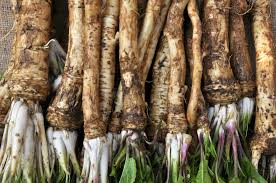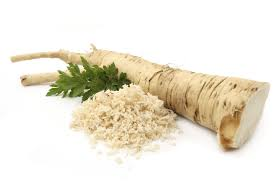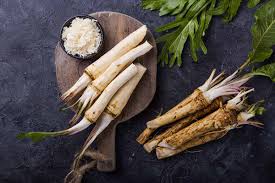Horseradish (Amoracia rusticana) has been a staple condiment for over 3,000 years, known for its sharp, peppery flavor. This hardy perennial is not only easy to grow, but it can survive harsh winters down to -20°F (-28°C), making it a perfect addition to most gardens. Though it’s a relative of cabbage, horseradish can be a bit invasive, so careful management is needed. However, when placed at the garden’s edge, it serves as an excellent barrier against weeds and foot traffic.
Growing Horseradish
Horseradish is simple to propagate either by purchasing roots from a nursery or using healthy roots from the market. Plant them in late fall or winter, and they’ll sprout in the spring. Typically, horseradish takes at least one full growing season, ideally two, before it’s ready for harvest. By late spring or summer, the plant may produce small white flowers, but these should be removed to conserve energy and prevent unwanted reseeding. While it’s a perennial, horseradish will continue to spread, and careful management will prevent seedlings from becoming a nuisance.

Harvesting Horseradish
Horseradish roots develop their characteristic pungency when grown in cool soil. Therefore, the best time to harvest is in the fall, winter, or early spring. For a quick harvest, you can dig up roots in autumn for immediate use at the table, or dig again just before the ground freezes. In spring, as the weather warms, you can harvest again or relocate new plants that may have sprung up in unwanted areas.
To harvest, use a digging fork to loosen the soil around the plant. Locate the taproot, which grows horizontally rather than straight down, and gently follow it with the fork to unearth the root. The largest and most usable roots will be around the diameter of your fingers, so these are ideal for harvesting. After digging, wash the roots, dry them, and store them in an airtight container in the fridge, where they will last for several weeks without releasing any strong odor.
Preparing Horseradish
To make prepared horseradish, it’s important to understand that its spicy compounds are activated by air exposure but are destroyed by heat. For best results, prepare horseradish fresh and store it in its raw form. A classic use for prepared horseradish is in sauces. Mix it into ketchup for shrimp cocktail sauce, into sour cream for a tangy accompaniment to meats, or into mayonnaise to create a creamy condiment like the familiar Arby’s Horsey Sauce.
For the smoothest texture in sauces, use a Microplane zester or grater to finely shred peeled horseradish roots. While a food processor might seem like a time-saver, it tends to create a lumpy puree, which works for dishes like Russian khren, but not for smooth creamy sauces. Before you begin grating, prepare a simple brine using one tablespoon each of vinegar and water, plus a quarter teaspoon of sugar and salt. This brine helps preserve the horseradish and balance its flavor.

As you grate the horseradish, work outdoors if possible, as the fumes can cause irritation. After each 3-4 minute session of grating, add the shredded root to the brine to halt the activation of its strong compounds. If needed, mix more brine to cover the root. Once made, prepared horseradish can be stored in the refrigerator for about a month, although it’s often gone much sooner due to its irresistible flavor.
Horseradish adds a warm, zesty kick to many dishes, from roasted vegetables to hot sandwiches. Its preparation is as rewarding as its taste, offering a homemade touch that store-bought condiments can’t match. Whether you’re adding it to sauces or enjoying it fresh, horseradish is a garden favorite with a long history of culinary use.
